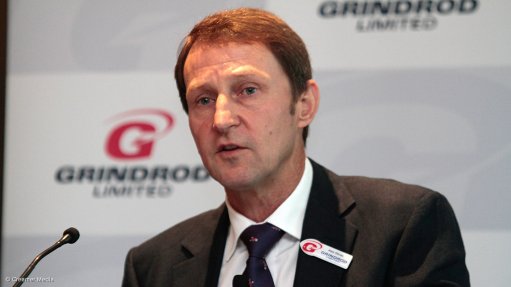
Grindrod CEO Alan Oliver
Photo by: Duane Daws
Freight and logistics service provider Grindrod had a R10-billion project pipeline planned for sub-Saharan Africa, said Grindrod CEO Alan Olivier on Thursday.
He told Engineering News Online that the capital expenditure for some of these projects had already been approved by the Grindrod board – R1.6-billion from 2014 to 2016.
The remaining projects were in various stages of development, and, for example, had either already been costed, or were awaiting regulatory approval or commitment from customers, said Olivier.
All the projects were aimed at creating new or replacement infrastructure in sub-Saharan Africa, allowing Grindrod to better service trade flows on the continent.
“We have the intention to raise R3-billion to support the pipeline of projects we have,” said Olivier in Johannesburg.
The Grindrod board had already approved this proposal.
“We remain focused on developing infrastructure – to use the opportunities we have to leverage that infrastructure to be a supplier of choice for logistics solutions,” said Olivier.
One of the projects Grindrod recently secured was the opportunity to work with Northwest Rail Company to build, operate and maintain a new 590 km Cape gauge railway from Chingola, in the heart of the old Zambian Copperbelt, to the Angolan border.
Rail was already big business for Grindrod.
Grindrod Freight Services Ports & Rail CEO Dave Rennie said the group had doubled capacity at its locomotive production plant in the past year.
Locomotive build opportunities less than a year out stood at around 30 units, with another 34 possible more than a year out.
Rennie said Grindrod was expanding the locomotive model range it was bringing to market.
The group’s focus “was outside” South African rail parastatal Transnet, targeting mainly industrial and mining complexes in Africa requiring locomotives.
Looking at the general business environment in which Grindrod operated, Olivier said industrial commodity demand continued globally, with economic growth in Africa still strong and “infrastructure opportunities intact”.
There was also continued growth in global dry-bulk seaborne trade, but severe competition and pricing volatility in the agricultural commodity market.
Grindrod saw volume at its Maputo port up 15% in 2013, to 17.2-million tons. Vehicles moved at the Maputo car terminal increased 50% after a doubling in capacity last year, to 71 368 units.
Following a poor performance in the agricultural commodity trading market, Grindrod was repositioning and reviewing its agricultural business, in a process that should be completed this year, said Olivier.
Grindrod on Thursday reported revenue of R32-billion for the year ended December 31, 2013, down from R35.26-billion in 2012 financial year, a period which was boosted by the 50% sale of Cockett Marine Oil.
Trading profit for the 2013 financial year was R1.78-billion, up from R1.44-billion.
Grindrod had net debt of R2.59-billion on December 31, up from R746-million in December 2012. Capital expenditure in subsidiaries and joint ventures in 2013 amounted to R2.9-billion.
Freight Services produced R5-billion in revenue in 2013. Operating income was R908-million, up 65% from 2012.
The Trading division, which housed the agricultural business, delivered R22.4-billion in revenue, and saw a 145% drop in operating income, to a loss of R110-million.
Shipping earned R4.3-billion in revenue, and saw operating income jump 244%, to R236-million.
Financial Services reported revenue of R371-million, and a 23% increase in operating income to R154-million.